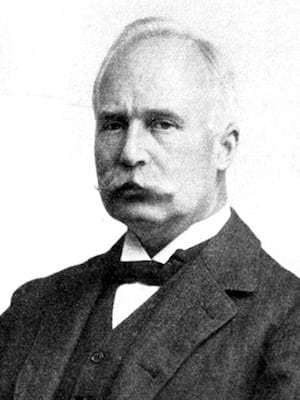Johann Hoffmann
Johann Hoffmann (1857 – 1919) was a German neurologist.
Widely regarded as the first ‘pure’ neurologist in Germany
Hoffmann’s interests centred on the spinaI cord and neuromuscular system and he continued the process of differentiation and delineation of the neuromyopathies which had been initiated by his mentors Nikolaus Friedreich (1825 – 1882) Wilhelm Heinrich Erb (1840 – 1921).
Many clinical contributions to neurology include his differentiation of myotonic dystrophy and myotonia congenita; the Hoffmann reflex; and an accurate description of hereditary motor neuropathy type 1, acknowledging the previous report of Werdnig (Werdnig-Hoffmann syndrome);
Biography
- Born on March 28, 1857 Rheinhessen, Germany
- Medical school, Heidelberg
- Assistant to Wilhelm Erb in the division of neurology
- 1910 – Full professor of medicine
- 1919 – Full professor of neuropathology
- Died on November 1, 1919 in Heidelberg, Germany
Medical Eponyms
Hoffmann reflex (1911)
The ‘Hoffmann reflex’ refers to the finger reflex for hyper-reflexia associated with upper motor neuron lesions. [Hoffmann-Tromner reflex]
Sudden release of the flexed distal phalanx of the second, third, or fourth digits leads to flexion of the terminal phalanx of the thumb and of the last two interphalangeal joints of other fingers of that hand in the case of pyramidal tract disease affecting that limb.
Hoffmann discussed this reflex in his teaching and used it in clinical practice, but never published. This reflex was documented in 1911 by his student Hans Curschmann (1875-1950). [Über die diagnostische Bedeutung des Babinskischen Phänomen im präurämischen Zustand. MMW, 1911;58(39): 2054-2057.]
Werdnig–Hoffmann syndrome (1891, 1893)
[Hereditary motor neuropathy type 1; Spinal muscular atrophy type 1] Presents with hypotonia in infancy, with weakness in the limb, intercostal and bulbar muscles. Inheritance is autosomal recessive. The disease was first described in 1891 by Guido Werdnig (1844-1919).
In 1893, Hoffmann wrote an account of ‘chronic familial spinal muscular atrophy’ which he later defined as ‘progressive spinal muscular atrophy’ in 1897. Subsequent descriptions by Sevestre (1899 – Paralysie flasque) and Hermann Oppenheim (1900 – myotonia congenita) led to ‘Werdnig-Hoffmann’ being applied specifically to spinal muscular atrophy
Hoffmann syndrome (1897)
Myopathy in hypothyroidism. Stiffness, slowed contraction/relaxation, and persistent painful muscle contractions following effort. Often associated with muscle hypertrophy in adult hypothyroid patients. [hypothyroid myopathy]
Charcot-Marie-Tooth-Hoffmann syndrome (1897)
Major Publications
- Hoffmann J. Die Lehre von der Tetanie. Deutsches Archiv für klinische Medicin, 1888; 43: 53-119. [Hoffmann sign/reflex]
- Hoffmann J. Weitere Beiträge zur Lehre von der Progressiven Neurotischen Muskelhydrophie. Deutsche Zeitschrift für Nervenheilkunde. 1891;1:95-120 [Werdnig–Hoffmann syndrome]
- Hoffmann J. Ueber chronische spinale Muskelatrophie im Kindesalter, auf familiärer Basis. Deutsche Zeitschrift für Nervenheilkunde, 1893;3: 427
- Hoffmann J. Weitere Beitrag Zur Lehre von der hereditären progressiven spinalen Muskelatrophie im Kindersalter nebst Bemerkungen über den fortschreitenden Muskelschwund im Allgemeinen. Deutsche Zeitschrift für Nervenheilkunde, 1897; 10: 292-320 [Charcot-Marie-Tooth-Hoffmann syndrome]
- Hoffmann J. Weiterer Beitrag zur Lehre von der Tetanie. Deutsche Zeitschrift fur Nervenheilkunde. 1897;9:278-290 [Hoffmann syndrome]
References
Biography
- Beighton P, Beighton G. Johann Hoffmann. In: The Man Behind the Syndrome. 1986: 76-78
Eponymous terms
- Sevestre M. Paralysie flasque des quatre membres et des muscles du tronc (sauf le diaphragme) chez un nouveau-ne. Bulletins de la société de pédiatrie de Paris, 1899; 1: 7-13
- Oppenheim H. Über allgemeine und lokalisierte Atonie der Muskulatur (Myatonie) im frühen Kindesalter. Monatsschrift für Psychiatrie und Neurologie. 1900;8:232–3
- Curschmann H. Über die diagnostische Bedeutung des Babinskischen Phänomen im präurämischen Zustand. Münchener medizinische Wochenschrift, 1911;58(39): 2054-2057.
- Bendheim OL. On the History of the Hoffmann Sign. Bulletin of the History of Medicine. 1937;5(7):684–686
- Koehler PJ, Bruyn GW, Pearce JMS. Neurological Eponyms. Oxford University Press 2000: 127-135.

